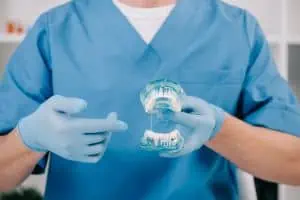When was the last time you thought about how many teeth adults have? Chances are, not recently, but now that you’re wondering how many teeth adults have, you’re in the right place for answers.
A pretty smile is considered to be one of the most beautiful features of a person and indicative of good oral health. Yet, most of us, however appreciative we may be of a smiling face, are careless when it comes to our teeth.
How many teeth do you have?
We could give you the quick answer: a full set of adult teeth consists of 32 teeth, including wisdom teeth. However, it’s actually not that simple. Many people have fewer teeth than this, even though they have never had any teeth removed. Why? Keep reading to find out.
This article also explains how many teeth kids have, and gives some detail on the names and functions of all the different teeth in the human mouth. So, whatever information you’re seeking about baby and adult teeth numbers, and how they impact oral health, you should find it here.
In This Article
How many teeth does a human have?
In this section, we will discuss the exact number of teeth in the human mouth. Most children have 20 teeth, and most adults have 32, but that’s not all we need to consider.
We humans have two separate sets of teeth in our mouth in a lifetime. One set replaces the other as we grow up. In our childhood, we have baby teeth, or deciduous teeth, that are replaced by permanent teeth in early adolescence.
Let’s discuss baby teeth first.
How many teeth do children have?

Between the ages of approximately 6 months to 33 months, children develop a whole set of teeth known as baby teeth. How many baby teeth do we acquire in childhood? The answer is 20.
Out of these, 10 are situated in the top jawbone or the maxillary arch, while the other 10 are at the bottom in the mandibular arch.
Also known as milk teeth, these are temporary and meant to fall out as we grow up.
Based on their unique shape, structure, and function, baby teeth are divided into three classes:
- 8 incisors
- 4 canines
- 8 molars
Incisor teeth
Incisors are the front four teeth in both the upper and lower jaws. There are eight of them and they are primarily used for cutting and slicing food. Out of these, the two teeth in the middle are known as the central incisors, and the two on the left and right sides are called lateral incisors.
Canine teeth
Also called cuspid teeth, canine teeth are used for tearing and cutting food. Canine teeth are similar in number, in both the primary and secondary set of teeth. Two canine teeth are present in the upper jaw and two in the lower jaw.
Molar teeth
Molars are known for their broad grinding surface which helps in smashing food and making it easier to swallow. There are a total of eight molars in children, four of which are known as first molars and the other four as second molars.
First molars come right after the canine teeth and second molars come next to the first molars as the last teeth in the back of the mouth.
Why is it important to look after baby teeth?

Many people believe that the first set of teeth is not as important, as they are eventually going to fall out. This is a common misconception for multiple reasons related to long-term oral health.
- Without proper cleaning, milk teeth can easily develop decay. If this reaches the inner tooth structure it will be very painful for the child.
- Decay can spread to the permanent teeth growing underneath, if it’s not treated.
- Infected teeth may need to be extracted, which can affect how the other teeth grow in and may cause crookedness.
- Having teeth removed in hospital can be traumatic for a child and may lead to fear of the dentist later in life.
- Children who are missing teeth prematurely may experience problems with eating and speech development.
How many teeth do adults have?

There are a total of 32 teeth in an adult set, including wisdom teeth. Of them, 16 teeth are in the upper jawbone (maxillary arch) and 16 are in the lower jawbone (mandibular arch). Unlike baby teeth, these teeth are divided into four different classes based on their shape and function:
- 8 incisors
- 4 canines
- 8 premolars
- 12 molars
Incisor teeth
An adult has eight incisor teeth similar to baby teeth. There are two central and two lateral incisors in both upper and lower jaws. These incisors are used to cut or tear into food.
Canine teeth
You have four canine teeth in your permanent, or adult, set. These can be found on the right and left sides of the lateral incisors in both the upper and lower jaw. The sharp surfaces of the canines help in the shredding of food.
Premolar Teeth
Premolars are the teeth that differentiate the adult set from the baby set of teeth. There are a total of eight premolars that are located between the permanent canines and the permanent molars.
On either side of your mouth, you will find two premolars sitting beside the canines in both the upper and lower jawbones. They occupy the position that has been vacated by the 1st and 2nd molars in your baby set of teeth.
Molar teeth
There are a total of 12 molars in an adult set of teeth, six of which are situated on top and six in the bottom on both upper and lower jaws. These teeth are used for grinding and chewing food to make it easier to swallow and digest.
Molars have a broad chewing surface which makes it easier to perform their function. The third set of these molars, comprising the last teeth in the back of the mouth, are the wisdom teeth. Wisdom teeth are the last teeth to erupt and are often removed due to pain occurring during their eruption.
Dentists have a way of numbering these teeth to keep track of them. If you want to see how dentists do this, watch Dr. Tamisha Denis discuss it below:
When do permanent teeth come in?
In normal circumstances, baby teeth start to fall out around age five or six and are gradually replaced by permanent teeth. All permanent teeth, except wisdom teeth, should erupt by the age of 12 or 13.
Permanent teeth usually appear in a particular pattern. This pattern has been summarized in the table below as per the guidelines of the American Dental Association. Not everyone’s teeth will follow this pattern exactly, so do not worry if you or your child’s teeth come through at slightly different times.
Upper teeth | Age of eruption | Lower teeth | |
Central incisors | 7–8 years | Third molars | 17–21 years |
Central incisors | 8–9 years | Second molars | 11–13 years |
Canines (cuspid) | 11–12 years | First molars | 6–7 years |
First premolars (first bicuspid) | 10–11 years | Second premolars (second bicuspid) | 11–12 years |
Second premolars (second bicuspid) | 10–12 years | First premolars (first bicuspid) | 10–12 years |
First molars | 6–7 years | Canines | 9–10 years |
Second molars | 12–13 years | Lateral incisors | 7–8 years |
Third molars | 17–21 years | Central incisors | 6–7 years |
Do all adults have 32 teeth?

No, not all adults have 32 teeth. Some people may have fewer teeth, and the most common reason for this is missing wisdom teeth. Wisdom teeth are the last to erupt in your mouth. They are so-called ‘wisdom teeth’ (although inaccurately) because they were thought to be connected to the actual development of wisdom.
Up to four wisdom teeth begin to erupt around the ages of 18-25 years. However, some people may only develop three, two, or even one of them in their entire lifetime. There are also a few lucky ones who may have no wisdom teeth at all. In these people, the total number of teeth will naturally be 28.
There is also a genetic condition called hypodontia that causes teeth to be missing. It’s thought that around 1.6% to 6.9% of the population are naturally missing one or more teeth (excluding wisdom teeth). This condition is most likely to affect the second premolars and the lateral incisors.
On the other hand, it’s also possible to have more than 32 teeth. People with more teeth than normal have a condition called hyperdontia. It’s quite rare, affecting just 3% of the population. Both hypodontia and hyperdontia are more likely to affect adult teeth than milk teeth.
In short, it’s the number of wisdom teeth in your mouth that decides how many teeth you will have in total. Depending on this, the number could range from 28-32. For more interesting dental facts like these check out our article about dental facts and statistics.
How many teeth we need
You must be thinking if we could survive with 20 teeth in a baby set, do we need all 32 teeth in our mouths? Do we need to replace teeth if we lose them somehow?
We have established by now that there are 32 teeth in our mouths, each of which has a specific role and function. When you chew your food, 80% of the work is done by the first molars. Second and third molars work together with the first molars and assist them in their job.
If you lose some of your teeth for whatever reason, the workload will be automatically re-distributed among the remaining teeth. This may burden them over time, leading to diseases of the gum and tooth.
You might develop tooth decay, cracks and fractures and sometimes even gum disease. Therefore, a lost tooth should be replaced as early as possible. A little carelessness on your behalf might lead to the loss of many teeth following the loss of one.
It is a popular saying in the medical world that people who have all their teeth will live a longer life. Although initially used as a marketing tactic, recent researchers have found a strong relationship between the number of teeth in the oral cavity and the general health of a person.
For example, if you develop heart disease, one of the most important questions asked by the healthcare practitioner will be about your oral health history. This is because there is a strong relationship between gum disease and cardiovascular problems. Similarly, research has also proven a direct impact of gum disease on joints and eyes.
The crux of the matter is that taking good care of your oral hygiene and not losing any teeth can eventually lead to a healthier and longer life.
Tips for keeping your teeth healthy
When it comes to oral hygiene, brushing is the most important part. According to dentists, you should brush at least twice a day. The type of toothpaste is also very important. Fluoride toothpastes are often considered better than toothpaste without fluoride.
A very common cause of tooth problems is improper brushing. You might be brushing twice a day but find that you are still suffering from tooth decay due to inappropriate brushing techniques. You can read our article about proper brushing if you have any doubts about how to brush your teeth.
Additionally, you may also follow the tips mentioned below:
- Add flossing to your daily oral hygiene routine
- Use a mouthwash, preferably a fluoridated one, at least once a day (but not right after brushing).
- Less sugar intake is beneficial to both your dental health and overall health.
- If you have a bad habit of grinding teeth and clenching and biting on hard objects, take steps to avoid it.
- Visit your dentist regularly. Twice a year is enough if your teeth don’t demand extra care.
Conclusion

So, how many teeth do we have? The answer is 20 milk teeth, which gradually fall out to make way for a set of 32 adult teeth – or perhaps a few less, depending on how many wisdom teeth you develop.
Each of these teeth in both sets is equally important and therefore must be taken care of if you wish to enjoy good oral health.
Take care of those chompers!
FAQs
Why are wisdom teeth removed?
The eruption of wisdom teeth is a painful process for most of us. The pain is usually due to decreased space in the mouth which leads to eruption at an angle or a partial eruption. Also known as impacted wisdom teeth, these teeth can adversely affect the jaw and cause improper alignment of the rest of the teeth. There would also be an increased risk of decay or plaque. Due to all these problems, around 60% of people get their wisdom teeth removed.
Is it okay to have 28 teeth?
Yes, having 28 teeth is perfectly normal. In fact, your mouth only has space for 28 teeth so it becomes painful when 32 teeth try to fit in that space. The extra four teeth are the wisdom teeth. They can be safely removed in case they cause pain.
How can I number my teeth?
If you want to number your healthy and diseased teeth, the best way is to visit a dentist. Dentists use charts to make notations and mark healthy and diseased teeth. In the U.S., the dentists use the Universal System for this purpose.
How many teeth do kids lose?
Children lose 20 teeth throughout their childhood. All of these are meant to fall out one by one over a period of several years in order to be replaced by permanent teeth. All children acquire a temporary set of teeth by the time they reach 33 months.
Archives of Oral Biology: Mineralization differences between human deciduous and permanent enamel measured by quantitative microradiography. Consulted 23rd January 2020.
BMJ Clinical Evidence: Impacted Wisdom Teeth. Consulted 23rd January 2020.
ADA.org: Tooth eruption. Consulted 23rd January 2020.
Informedhealth.org: Wisdom teeth: Overview. Consulted 23rd January 2020.




